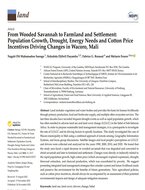Land includes vegetation and water bodies and provides the basis for human livelihoods through primary production, food and freshwater supply, and multiple other ecosystem services. The
last three decades have recorded frequent drought events as well as rapid population growth, which has often resulted in adverse land use and land cover change (LULCC) in the Sahel of Sub-Saharan Africa. In order to propose sustainable land management strategies, it is a prerequisite to investigate the rate of LULCC and its driving factors in specific locations. This study investigated the case of Wacoro municipality in Mali using a combined approach of remote sensing, Geographic Information Systems, and focus group discussions. Satellite images and local people’s perceptions on LULCC and drivers were collected and analyzed for the years 1990, 2000, 2010, and 2020. We found that the study area faced a rapid decrease in wooded savannah that was degraded and converted to shrub savannah and later to farmland and settlement. Changes were directly or indirectly related to the rapid population growth, high cotton price (which encouraged cropland expansion), drought, firewood extraction, and charcoal production, which was exacerbated by poverty. We suggest promoting integrated land management strategies that consider current and future livelihood needs and preserve the environment for the benefits of future generations. New agricultural policies, such as cotton price incentives, should always be accompanied by an assessment of their potential environmental impacts and design of adequate mitigation measures.

